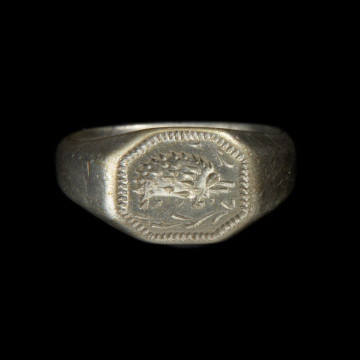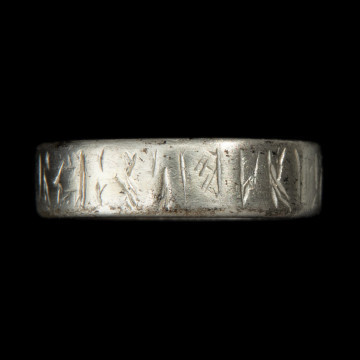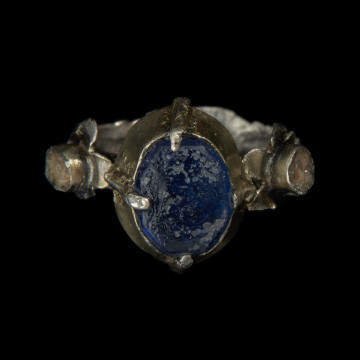
Signet ring with hedgehog
przełom XIV i XV wieku
National Museum in Szczecin
Part of the collection: Stone Age
An ornament made from the shell of a mussel of the genus Spondylus was found in a grave discovered in Karsk (German: Schöningsburg) in 1884. It was found by accident during autumn mounding of swedes on an elevation by the northern edge of the Lake Płoń basin. At a depth of about 25 cm an inhumation burial of a man was discovered. The skeleton was arranged along an east-west axis. By the skull, placed on the eastern side, there were four clay vessels preserved in fragments, and by the legs there was a stone axe, a pair of boar tusks and three flint products. Hermann von Schöning, the heir to the Karsk estate, donated part of the artefacts to the collection of the Society for History and Antiquities of Pomeranian in Szczecin, and the rest was added to the family collection in Żukowo. A medallion made of half a shell with holes for hanging was the only piece of burial equipment not mentioned in the description of the find from the beginning of November 1884. In the heavy clay soil, which clung to the objects, the massive bowl-shaped shell was probably indistinguishable from the pottery and came with them to Szczecin. It only appears in the entry on the certificate, which lists the vessels that had already been lined. The ornamentation did not appear in the literature until the 1920s. Spondylus shells (Spondylus gaederopus species) living in the north-eastern waters of the Mediterranean Sea were eagerly used by Neolithic communities originating from the Danube circle for making various types of personal ornaments, pendants, clasps, bracelets and beads. Their distribution is considered the oldest long-distance exchange network of prestige products in prehistoric Europe. Several ornaments made of hinge shell are known from Polish lands, including two medallions similar to the one discovered in Karsk. The grave from Karsk, associated with younger groups of the Corded Ware originating from the Danube circle, can be approximately dated to the 1st half of the 5th millennium BC.
Krzysztof Kowalski
Author / creator
Dimensions
cały obiekt: height: 8 cm, width: 7.5 cm
Object type
adornment, pendant
Technique
drilling, hand made
Material
shell
Creation / finding place
Owner
National Museum in Szczecin
Identification number
Location / status

przełom XIV i XV wieku
National Museum in Szczecin

przełom XIV i XV wieku
National Museum in Szczecin

National Museum in Szczecin
DISCOVER this TOPIC
Museum of King Jan III's Palace at Wilanów
DISCOVER this PATH
Educational path